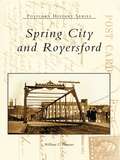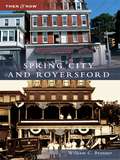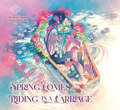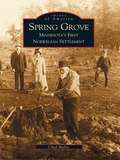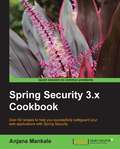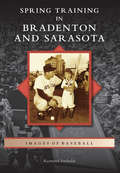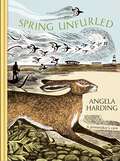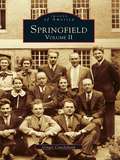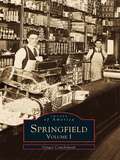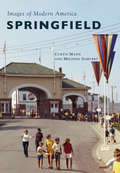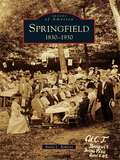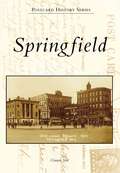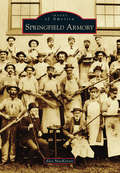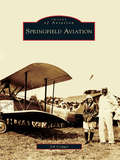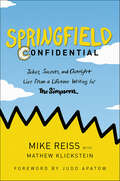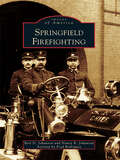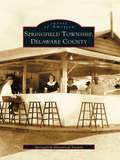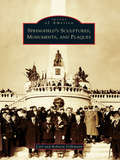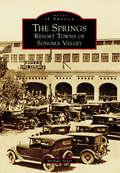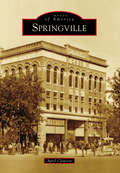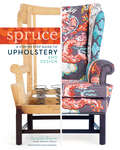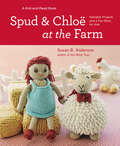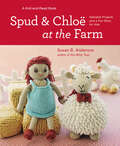- Table View
- List View
Spring City and Royersford: Through Time (Postcard History Series)
by William C. BrunnerIn 1824, the completion of the Schuylkill Canal gave birth to Spring City, and the opening of the Philadelphia and Reading Railroad in Royersford soon followed. Over the years, the "twin boroughs" grew simultaneously, sharing the community and industrial developments that their respective transportation hubs fostered. Spring City and Royersford, through more than two hundred vintage postcards, shares the history of these sister towns: the stove factories, glassworks, and knitting mills that were found on both sides of the river; the floods, fires, and train wrecks that the towns endured; and the bridges, schools, and celebrations that help unite the two communities.
Spring City and Royersford: Through Time (Then and Now)
by William C. BrunnerIn 1824, the completion of the Schuylkill Canal gave birth to Spring City, and the opening of the Philadelphia and Reading Railroad in Royersford soon followed. Over the years, the "twin boroughs" grew simultaneously, sharing the community and industrial developments that their respective transportation hubs fostered. Spring City and Royersford, through more than two hundred vintage postcards, shares the history of these sister towns: the stove factories, glassworks, and knitting mills that were found on both sides of the river; the floods, fires, and train wrecks that the towns endured; and the bridges, schools, and celebrations that help unite the two communities.
Spring Comes Riding in a Carriage: Maiden's Bookshelf (Maiden's Bookshelf #5)
by Riichi YokomitsuA more intimate and romantic entry in the Maiden's Bookshelf series, this tale of doomed romance brings together the so-called "God of Literature" with the gorgeous artwork of Atsuki Ito, author of A Love-Letter in 26 Characters.&“I can't imagine how wonderful it will be to die...&” Confined to a sickbed by the seaside, a woman waits for death as her husband nurses her. This is no tragic idyll, however; the space between them is filled with antagonism, fear, suspicion, pain...and love.Riichi Yokomitsu brings a bitingly realistic sensibility to this claustrophobic tale of love and death, asmoving as it is agonizing.
Spring Grove: Minnesota's First Norwegian Settlement
by Chad MullerSpring Grove: Minnesota's First Norwegian Settlement is a tribute to the state's earliest Norwegian emigrants, and to generations of Norwegian Americans who have made this small farming community amongst deep valleys, fjord-like bluffs, and winding streams their true vesterheim. It is a tale told through striking historic photographs, many previously unreleased, and personal narratives, often humorous and always insightful.The area was first settled in the 1850s by pioneers like James Smith, who, inspired by the landscape, named the place Spring Grove. Smith was followed by the likes of "Big" Ole Gulbransgutton, who chased crooked land surveyors out of town with his bare fist; by the innovative Mons Fladager, whose business acumen earned him the title of "Father of Spring Grove"; and by the 20th-century cartoonist Peter J. Rosendahl, whose work gave a comical voice to the challenges of cultural assimilation. Spring Grove: Minnesota's First Norwegian Settlement also conveys the universality of the Norwegian immigrant experience, and anyone with Norwegian roots who desires to learn more about their ancestors will find it an enjoyable read.
Spring Security 3.x Cookbook
by Anjana MankaleThis book follows a cookbook style exploring various security solutions provided by Spring Security for various vulnerabilities and threat scenarios that web applications may be exposed to at the authentication and session level layers.This book is for all Spring-based application developers as well as Java web developers who wish to implement robust security mechanisms into web application development using Spring Security.Readers are assumed to have a working knowledge of Java web application development, a basic understanding of the Spring framework, and some knowledge of the fundamentals of the Spring Security framework architecture. Working knowledge of other web frameworks such as Grails and so on would be an added advantage to exploit the whole breadth of recipes provided in this book, but this is not mandatory.
Spring Training in Bradenton and Sarasota (Images of Baseball)
by Raymond SinibaldiMcKechnie Field in Bradenton, Florida, is the oldest active major-league spring-training facility in the country. Opened in the spring of 1923 with Commissioner Kenesaw Mountain Landis in attendance, it has played host to six different major-league teams, with the Pittsburgh Pirates calling it home since 1969. The New York Giants traveled to Sarasota in 1924 as the first of five teams to venture to its confines. These two cities, both situated on the Gulf Coast of Florida, boast nearly a century of baseball history and have seen the game's all-time greats.
Spring Unfurled: part of a beautiful new series from beloved illustrator and print-maker Angela Harding
by Angela Harding'Spring, at all its stages, has an energy that engages us with the outside world.'Spring Unfurled is the first in a stunning seasonal quartet from beloved printmaker and illustrator Angela Harding.'Seasonal change has always been a great inspiration for my artwork. I love the changing light that brings new colours and smells. The seasons are nature's clock, bringing birds from distant shores to nest and breed in our gardens. So it is hard to say exactly when one season stops and the other begins; the changes are not necessarily gradual but come in fits and starts. Seasons have no regard for the official times written down in a calendar. Spring, more than any other of the seasons, is like this.'This pocket-sized series takes readers on a journey through the seasons, reflecting Angela's view as the nature around her transforms and evolves over the months. Taking in landscapes across the UK, from views from her home studio in Rutland to the Scottish wilderness, via the low-lying marshlands of Suffolk and the windswept hills of Yorkshire, the beautiful illustrations and evocative imagery of the prose make this the perfect book for nature lovers and art lovers everywhere.Featuring Angela's most beloved prints, alongside Angela's observations and inspirations, Spring Unfurled, Summer's Hum, Falling into Autumn and Winter's Song are a joyful celebration of nature and wildlife across the UK at all times of year.
Spring Unfurled: the beautiful new book from beloved illustrator and print-maker Angela Harding
by Angela Harding'Spring, at all its stages, has an energy that engages us with the outside world.'Spring Unfurled is the first in a stunning seasonal quartet from beloved printmaker and illustrator Angela Harding.'Seasonal change has always been a great inspiration for my artwork. I love the changing light that brings new colours and smells. The seasons are nature's clock, bringing birds from distant shores to nest and breed in our gardens. So it is hard to say exactly when one season stops and the other begins; the changes are not necessarily gradual but come in fits and starts. Seasons have no regard for the official times written down in a calendar. Spring, more than any other of the seasons, is like this.'This pocket-sized series takes readers on a journey through the seasons, reflecting Angela's view as the nature around her transforms and evolves over the months. Taking in landscapes across the UK, from views from her home studio in Rutland to the Scottish wilderness, via the low-lying marshlands of Suffolk and the windswept hills of Yorkshire, the beautiful illustrations and evocative imagery of the prose make this the perfect book for nature lovers and art lovers everywhere.Featuring Angela's most beloved prints, alongside Angela's observations and inspirations, Spring Unfurled, Summer's Hum, Falling into Autumn and Winter's Song are a joyful celebration of nature and wildlife across the UK at all times of year.
Springfield: Volume I
by Ginger CruickshankSituated at the crossroads of New England, Springfield, Massachusetts, was founded in 1636 by twelve families led by William Pynchon, who named the settlement after his birthplace in England. This book, the first of a two-volume set, is a collection of many never-before-seen photographs that tell the story of this city's history. Springfield is a city of "firsts." The first successful gasoline-poweredengine was built by the Duryea brothers here; the first U.S. musket was made at the Springfield Armory; and in 1891, resident Dr. James Naismith invented the game of basketball. The city's ties to the U.S. military are illustrated here, as are its many religious and ethnic communities. Within these pages, we can see images of a very different Springfield, including buildings much changed or long gone, and people remembered now in family albums.
Springfield: Volume I
by Ginger CruickshankSituated at the crossroads of New England, Springfield, Massachusetts, was founded in 1636 by twelve families led by William Pynchon, who named the settlement after his birthplace in England. This book, the first of a two-volume set, is a collection of many never-before-seen photographs that tell the story of this city’s history. Springfield is a city of “firsts.” The first successful gasoline-poweredengine was built by the Duryea brothers here; the first U.S. musket was made at the Springfield Armory; and in 1891, resident Dr. James Naismith invented the game of basketball. The city’s ties to the U.S. military are illustrated here, as are its many religious and ethnic communities. Within these pages, we can see images of a very different Springfield, including buildings much changed or long gone, and people remembered now in family albums.
Springfield: A Reflection In Photography (Images of Modern America)
by Curtis Mann Melinda GarvertThe 1960s and 1970s were a time of significant change in the history of Springfield, Illinois, as the city redefined itself through major developments in education, technology, and commerce. This pictorial history allows readers to remember the familiar places of those decades, such as the downtown area, and acquaint themselves with the history of the new institutions that started in this time period. Colorful images, many taken by amateur photographers, document the theme of change in the landscape and culture of Springfield as the city moved into the future.
Springfield: A Reflection in Photography
by Curtis R. Mann Melinda L. Garvert Edward J. RussoSpringfield: A Reflection in Photography is a photo album of Springfield scenes from the late 19th through the mid 20th centuries-a nostalgic look back at everyday life in the capital city. Local people are seen at work, at play and socializing. Iron workers, construction crews and munitions makers show us the gritty, tiring work of a community and emphasize the man and animal power once common in industry. There are social changes as well, like the coming of women to the workplace. Shirtwaisted ladies at the Illinois Watch Company and "Rosie the Riveter" on the production line during the war make their appearance. Aerial views of the downtown area present a century of change in Springfield. The evolution of transportation in the community is chronicled, from horse and buggy to the railroad to the automobile. Images of ladies cooking at Temple and crews preparing community garden plots showcase the city's volunteer service heritage. Commonplace images of life in Springfield, such as children at play, shopping, parades, and the first day of school, are all presented here. But the less common events are included as well: fires, the race riot, even a baptism at Lake Springfield. Together, these images tell the story of who we were, and perhaps more importantly, who we have become as a result. This book shows a community readers may know intimately, yet have never seen.
Springfield: 1830-1930
by Anita L. RobertsSpringfield, now the third-largest city in the state, was once an area favored by Native Americans for its natural beauty, mild climate, abundant timber, and excellent hunting and fishing. Founded by John Polk Campbell in 1829, the settlement grew steadily, thanks to its civic-minded residents. Springfield's many photographs show these diligent people at work as well as at play. Whether enjoying a vaudeville show at the Landers Theatre in 1891, riding a jitney or streetcar to Doling Park in 1915, or playing in the world's largest Boy Scout Band in 1925, the people of Springfield enjoyed themselves. Images depict businesses such as the Springfield Wagon Company, which became "king" of U.S. wagon manufacturing, and the "Frisco," whose operational hub was housed in Springfield, bringing commercial and industrial diversification. In 1926, the city became the birthplace of the Mother Road, Route 66, which firmly established Springfield's right to the name "Queen City of the Ozarks."
Springfield (Postcard History Series)
by Connie YenKnown as the "Queen City of the Ozarks," Springfield was founded in 1829 and became the seat of Greene County in 1835. Beginning in 1870, Springfield served as a railroad hub that connected the Ozarks culturally and financially to Kansas City, St. Louis, Chicago, and points along the East Coast. In 1938, Route 66 became part of the city's history when the legendary highway came through the public square on College Street. Built on land donated by Springfield founder John Polk Campbell, the square continues to be a vital part of the city's culture and economy. Postcard History Series: Springfield illustrates the community's growth from downtown businesses to the spread of schools, hospitals, and parks across the city.
Springfield Armory (Images of America)
by Alex MackenziePres. George Washington authorized Springfield Armory to begin manufacturing small arms for the US military in 1794. Over nearly two centuries until its closure in 1968, the government armory at Springfield, Massachusetts, became legendary, not only for the arms provided to soldiers during conflicts such as the War of 1812, the Civil War, and World War II, but also for the way in which those arms were crafted. The drive to produce firearms of high quality and quantity for the nation's military created a need to improve manufacturing methods and machinery. Armory advancements, such as the interchangeability of parts, helped lay the groundwork of the American Industrial Revolution. Because of these efforts, Springfield Armory is recognized not only as a first-rate government arms manufacturer, but also as a hub of industry, attracting thousands of skilled men and women from around the world.
Springfield Aviation (Images of Aviation)
by Job CongerCitizens of Springfield first witnessed human flight, a balloon ascent, on July 5, 1858. In 1861, the capital city's most famous resident, Abraham Lincoln, then residing in the White House, authorized the creation of the first U.S. "air force," a balloon to observe Confederate troops. Springfield's interface with aviation has been a steady stream of hot-and-cold-running enthusiasm since airplanes began flying from the state fair racetrack infield about 1910. Springfield Aviation chronicles that flow and concludes with photographs from Abraham Lincoln Capital Airport in early 2008. It presents photographs of memorable airplanes, airships, and prominent aviators from the author's extensive collection, augmented by contributions from Springfield Airport Authority, Lincoln Library's Sangamon Valley Collection, and many others.
Springfield Confidential: Jokes, Secrets, and Outright Lies from a Lifetime Writing for The Simpsons
by Mathew Klickstein Mike ReissSemi-Finalist for the 2019 James Thurber Award * One of Vulture's Top-10 Comedy Books of 2018 * A "Must" pick by Entertainment Weekly * An A.V. Club Best Books selection * A "New and Noteworthy" selection by USA TodayIn celebration of The Simpsons thirtieth anniversary, the show’s longest-serving writer and producer offers a humorous look at the writing and making of the legendary Fox series that has become one of the most revered artistic achievements in television history.Four-time Emmy winner Mike Reiss—who has worked on The Simpsons continuously since episode one in 1989—shares stories, scandals, and gossip about working with America’s most iconic cartoon family ever. Reiss explains how the episodes are created, and provides an inside look at the show’s writers, animators, actors and celebrity guests. He answers a range of questions from Simpsons fans and die-hards, and reminisces about the making of perennially favorite episodes.In his freewheeling, irreverent comic style, Reiss reflects on his lifetime inside The Simpsons—a personal highlights reel of his achievements, observations, and favorite stories. Springfield Confidential exposes why Matt Groening decided to make all of the characters yellow; dishes on what it’s like to be crammed in a room full of funny writers sixty hours a week; and tells what Reiss learned after traveling to seventy-one countries where The Simpsons is watched (ironic note: there’s no electricity in many of these places); and even reveals where Springfield is located! He features unique interviews with Judd Apatow, who also provided the foreword, and Conan O'Brien, as well as with Simpsons legends Al Jean, Nancy Cartwright, Dan Castellaneta, and more. Like Cary Elwes’ As You Wish, Jennifer Keishin Armstrong’s Seinfeldia, and Chris Smith’s The Daily Show: An Oral History, Springfield Confidential is a funny, informational, and exclusive look at one of the most beloved programs in all of television land.
Springfield Firefighting (Images of America)
by Fred Rodriguez Bert D. Johanson Nancy B. JohansonThe history of the Springfield Fire Department dates back to 1792 when the first hand pumper, Lion, was purchased. On January 24, 1794, a fire club with 50 members, all prominent citizens of the city, was organized. Fire districts were established in 1830 by an act passed by the Massachusetts legislature. By 1833, Springfield officially organized a fire department, and like the fire club, the new volunteer department consisted of prominent members of the community. The fire department changed from volunteer to paid in 1872. The volunteers then formed the Springfield Veteran Fireman's Association. After 1872, the department made great strides, especially in the area of apparatus. In 1906, Springfield entered the motorized age with the introduction of a Knox squad truck, and by 1916, Springfield became the first fullymotorized fire department in the United States.
Springfield Township, Delaware County (Images of America)
by Springfield Historical SocietyCarved out of the wilderness in the 1680s, Springfield Township was formed as Quaker families seeking religious freedom settled the area. In a region roughly bounded by Darby Creek to the east and Crum Creek to the west, the early settlers shared forests with the native Lenni Lenape tribe. Just nine miles west of the port of Philadelphia, Springfield harnessed tumbling creeks with mills during the industrial revolution and provided the growing commonwealth with edge tools from Beatty Ax Works and fabric from Victoria Plush Mill. Builders used abundant stone quarries to construct grand homes, including that of the Pennsylvania Railroad's first chief engineer, J. Edgar Thomson, who laid out the famous Horseshoe Curve and Main Line to Pittsburgh. The construction of the Media Shortline Trolley helped Springfield grow, as did the Saxon Avenue Shops and unique developments such as Windsor Circle and Rolling Road. Springfield Township documents the area's transformation into a modern town rich with amenities and community organizations.
Springfield's Sculptures, Monuments, and Plaques
by Carl Volkmann Roberta VolkmannSpringfield is the capital of Illinois and the home of Abraham Lincoln and Vachel Lindsay. The city is filled with history, and that fact is reflected in the many sculptures, monuments, and plaques that have been commissioned to commemorate this history. The city contains more than 14 statues and busts of Abraham Lincoln. Famous sculptors have created 17 statues inside the state capitol alone, and 13 more statues and sculptures are located on the capitol grounds. The state's Capital Development Board sponsors the Art-in-Architecture program and provides funding for newly commissioned sculptures in state-funded public buildings. Several major American sculptors are represented in the many works, including Leonard Volk, Leonard Crunelle, Larkin Mead, Fred Torrey, and James Earl Fraser. Works of contemporary artists such as Michael Dunbar, Richard Hunt, and Preston Jackson are also present. Oak Ridge Cemetery contains four war memorials and Abraham Lincoln's tomb. Each of the sculptures, monuments, and plaques has a story to tell and helps to make Springfield's history come alive.
Springs, The: Resort Towns of Sonoma Valley (Images of America)
by Michael AckerThe Springs area of Sonoma Valley has a fascinating history going back to Spanish colonization of California, continuing through the Mexican period with Vallejo and the mid-19th-century sojourns of Hooker and Leavenworth, and moving into the flowering of the geothermal resort era in the 1880s. Eventually, the unincorporated towns of Boyes Hot Springs, Fetters Hot Springs, Agua Caliente, and El Verano became collectively known as The Springs, which were thriving resort communities from the 1880s through the 1960s. Sharing an illustrious history with the adjacent city of Sonoma, they continue to thrive in new ways into the 21st century. In this volume, the story of the valley is well documented in postcards, snapshots, and newspaper photographs and articles.
Springville (Images of America)
by April ClawsonLocated south of Provo, Utah, is artistic Springville. In 1776, Catholic explorers were the first to map this region. Native Americans enjoyed this locale for its abundance of wild game and its ready access to water. Brigham Young, a president of the Church of Jesus Christ of Latter-day Saints, asked men to examine the area in 1848. Capt. Aaron Johnson and the few families who were asked to settle here arrived in mid-afternoon on September 18, 1850. Hobble Creek was the first name given to the settlement, and that title is still used today by some local venues. In 1853, the Legislative Assembly of the Territory of Utah approved the city charter, and the first municipal election took place. Springville was then officially named after the large springs in the vicinity.
Spruce: A Step-by-step Guide To Upholstery And Design
by Grace Bonney Amanda BrownDiscover the joys of upholstery and bring new life to your worn-out furniture. With a few basic tools, an eye for color, and some ingenuity, you can customize your home with fabrics and textures that reflect your unique personality. This comprehensive guide features more than 900 photographs and includes five projects designed to teach you all you need to know to reupholster any piece of furniture. You’ll soon be confidently stripping down old sofas, stuffing sagging ottomans, and revamping chairs with your own distinctive style.
Spud and Chloe at the Farm: Regular Version
by Susan B. AndersonA knit-and-read book: 13 farm-centric projects for the perfect homespun toys, with a bonus story. A mother hen and her chicks (and their adorable knitted eggshells), three little piglets, and a black lamb full of good intentions are just some of the appealing projects in Spud and Chloë at the Farm, the latest innovative work from author and world-class knitter Susan B.Anderson. The projects in this book follow Spud, a feisty pet sheep, and Chloë, his perky owner, as they travel to a farm and meet the inhabitants of the barnyard, including a brown cow, some mice, a dog, and a barn cat. To continue the theme, and set the stage for loads of interactive play, the book also offers instructions for making an assortment of farm props, such as a picket fence, bales of hay, dainty baskets, and even a three-sided foldable barn.Meanwhile, witty full-color cartoons (presented one per spread throughout the text of the book) tell the story of Spud and Chloë’s visit to the farm, which starts with an invitation from Spud’s cousin Little Lamb. Featuring charming full-color photographs of the knitted toys, this book is a must-have for knitters and their loved ones.
Spud and Chloe at the Farm: Enhanced Version
by Susan B. AndersonA knit-and-read book: 13 farm-centric projects for the perfect homespun toys, with a bonus story. A mother hen and her chicks (and their adorable knitted eggshells), three little piglets, and a black lamb full of good intentions are just some of the appealing projects in Spud and Chloë at the Farm, the latest innovative work from author and world-class knitter Susan B.Anderson. The projects in this book follow Spud, a feisty pet sheep, and Chloë, his perky owner, as they travel to a farm and meet the inhabitants of the barnyard, including a brown cow, some mice, a dog, and a barn cat. To continue the theme, and set the stage for loads of interactive play, the book also offers instructions for making an assortment of farm props, such as a picket fence, bales of hay, dainty baskets, and even a three-sided foldable barn.Meanwhile, witty full-color cartoons (presented one per spread throughout the text of the book) tell the story of Spud and Chloë’s visit to the farm, which starts with an invitation from Spud’s cousin Little Lamb. Featuring charming full-color photographs of the knitted toys, this book is a must-have for knitters and their loved ones.
